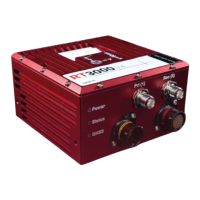Oxford Technical Solutions Ltd Page 68 of 110
Table 24: Serial outputs
Disabled
The serial output is disabled. This option can be used to reduce the
computational load and ensure that the Kalman filter runs quicker
NCOM
Normal output of the RT1003. NCOM data is transmitted at up to 125 Hz over
serial. The format is described in the NCOM Description Manual. Software
drivers exist for decoding the NCOM data
IPAQ
NCOM output at a reduced rate. The baud rate of the serial port is set to 19200
and the update rate is 25 Hz. It is used because the IPAQ cannot manage to
receive the data reliably above 25 Hz
IPAQ+
NCOM output at a reduced rate and polled. Windows Mobile 5 on IPAQs crashes
if the INS is sending data when the IPAQ is turned on. Using IPAQ+ the IPAQ will
poll the INS; the INS will not send data while the IPAQ is off, pre venting the
turn-on crash of the IPAQ
NMEA
The NMEA outputs conform to the National Marine Electronics Association
Standard (NMEA 0183 version 3.01 The NMEA sentences available are GPGGA,
GPHDT, GPVTG, GPZDA, GPGST, PASHR, GPRMC, GPGSV, GPGSA, PTCF, GPPPS,
PRDID, GPROT, GPGGK, and GPUTC. The NMEA 0183 description manual gives
details of the fields output in the NMEA sentences
Javad I+RTK
A special set of messages output in GREIS format to be used with Javad
receivers. For assistance please contact OxTS for support
MCOM
Used for marine applications. Identical to NCOM output but with the addition of
heave measurements
TSS1 TSS I format outputting acceleration, heave, roll and pitch
TSSHHRP TSSHHRP format
EM3000 Suitable for use with Simrad EM3000 multibeam sounders
EM1000 Suitable for use with Simrad EM1000 multilkam sounders
Note that it is easy to overload the serial port if there are too many events. The software computes the number
of characters that will be output each second and displays this at the bottom of the window. A serial port data
overflow warning message will appear if the data rate is too high for the selected baud rate; to fix this it is
necessary to lower the data rate of the selected NMEA sentences or increase the baud rate.
Selecting “Allow extended length messages” enables the full GGA and RMC messages to be output, which are
longer than the NMEA specification allows. Please see the NMEA 0183 Description manual for more details.
Selecting “Output approximate values before initialisation” forces output of the raw GNSS measurements
before the RT is initialised. Currently just the position is output and this is the position of the antenna, not the
inertial measurement unit. Note that there will be a jump (from the antenna to the inertial measurement unit)
when initialisation occurs.

